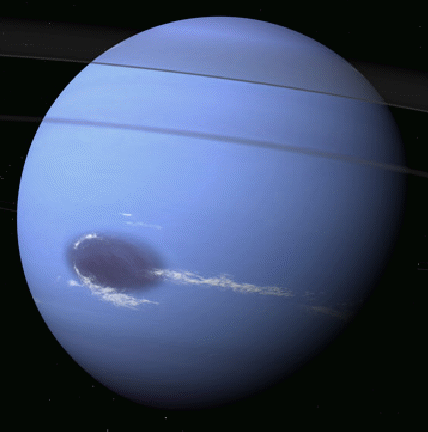Neptunes Great Dark Spot
Neptune's Great Dark Spot is an collection of atmospheric phenomena on Neptune similar to Jupiter's Great Red Spot thought to represent a hole in the layers of methane in Neptune's atmosphere. The first one was observed in 1989 by NASA's Voyager probe. Like Jupiter's spot, they are anticyclonic storms but the interiors of the Neptune's spots are relatively cloud-free, and unlike Jupiter's spot, which has lasted for hundreds of years, the lifetimes of Neptune's spots are much shorter - only several years. Based on observations taken by Voyager and the Hubble Space Telescope, Neptune appears to have a dark spot over half the time.

The spots are the shape of an ellipse with dimensions 13,000 × 6,600km, or 8,100 × 4,100 miles) roughly the same size as Earth. Around the Spot, wind speeds are blow up to 2,400 km per hour, the fastest in the Solar System.
The spots generates large white clouds at or just below the tropopause, similar to high-altitude cirrus clouds found on Earth. Unlike the clouds on Earth, which consist of ice crystals, Neptune's cirrus clouds consist of crystals of frozen methane and while cirrus clouds on Earth usually form and then disperse within a period of a few hours, the clouds in the Great Dark Spot were still present after 36 hours, or two rotations of the planet.
Neptune's spots are thought to occur in the troposphere at lower altitudes than the brighter upper cloud deck features.They are stable features that can persist for several months, and are thought to be vortex structures.
When the spot was to be photographed in November 1994 by the Hubble Space Telescope, it had disappeared completely but an almost identical spot emerged in Neptune's northern hemisphere. This new spot, called the Northern Great Dark Spot (NODS), has remained visible for several years.